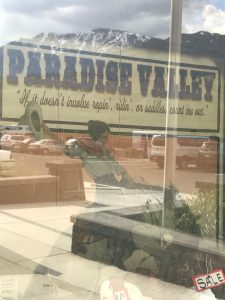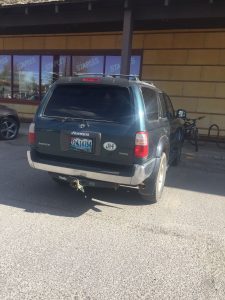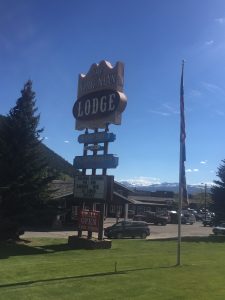Place as Text: Gardiner
May 28th, 2017 at 7:17 pm
Hello All!
We are currently finishing our stay in Gardiner. After spending five days in Gardiner it was quite the experience for our pack. Throughout our visit we ventured to just about every corner of this small town. We stopped in many restaurants, shops, and checked out many of the tourist attractions. From checking these places out we came to realize that tourism is what keeps this town running.
 (The picture to the left is of the original entry way into Yellowstone which tourist still travel through today).
(The picture to the left is of the original entry way into Yellowstone which tourist still travel through today).
Just yesterday we visited The Everything Store, on Park Street, and talked to a very unique lady that owned the shop and has lived here for seventeen years. She told us that “tourism is the town,” and that any interruption to the constant flow of tourists has a huge impact on the Gardiner community. A few years ago Yellowstone decided to upgrade the entrance to Gardiner by paving it and planting some new trees and bushes, but the lady at the shop told us that when they closed the area to do the upgrades that the lack of business hit them hard and it still hasn’t caught back up, and won’t for a while. The last thing she said to us was that the park is a joke to many of the locals because they would stand up for the park, but if they were ever struggling then the park would not stand up for them. She wishes that the park would just do some simple things like adding trashcans to their upgraded area. It’s really ironic that the town feels that way about the park because the Roosevelt Arch at the entrance says, “For the benefit and enjoyment of the people.”
Gardiner is a gorgeous place from the views and the wildlife to the architecture and wild-west feel. The town is clearly set up to highlight the views and draw in  tourists. Gardiner also has shorter buildings just like Jackson so that you can enjoy the views from anywhere in town. The entrance to the town, which is the north entrance into the park is beautiful and shows off the entrance to Yellowstone with some beautiful architecture and the Roosevelt arch. This is such a cool way to come into the community and you get the western vibe they want you to feel. Another interesting thing about the architecture is that they are trying to modernize the town, which means construction and the beginning of big changes for Gardiner. On Main Street we noticed that the K Bar, a bar and pizza restaurant, has a very old-fashioned western, saloon style appearance but the building being built right next door has a more modern design. This is just the beginning of what could be an entirely new community in the not too distant future.
tourists. Gardiner also has shorter buildings just like Jackson so that you can enjoy the views from anywhere in town. The entrance to the town, which is the north entrance into the park is beautiful and shows off the entrance to Yellowstone with some beautiful architecture and the Roosevelt arch. This is such a cool way to come into the community and you get the western vibe they want you to feel. Another interesting thing about the architecture is that they are trying to modernize the town, which means construction and the beginning of big changes for Gardiner. On Main Street we noticed that the K Bar, a bar and pizza restaurant, has a very old-fashioned western, saloon style appearance but the building being built right next door has a more modern design. This is just the beginning of what could be an entirely new community in the not too distant future.
 (This is a picture of a store front incentivizing tourist to come in because of a sale they are having. You can also see the mountains in the glare).
(This is a picture of a store front incentivizing tourist to come in because of a sale they are having. You can also see the mountains in the glare).
Not to our surprise, the prices here were high on everything just like Jackson. The only noticeable difference here is that alcohol was much cheaper than Jackson and even Farmville. One interesting thing we noticed was that there was no sales tax on everything we purchased. Our pack also spoke to a worker at the General pharmacy, a couple doors down from The Everything Store, who told us that sales tax doesn’t start until June 1st and ends September 1st, which is surprising because that is basically unheard of at home.
Just like everywhere else, one of our favorite parts of Gardiner is the wildlife. Gardiner is so much closer to the park than the other places we have visited, which brings a lot more wildlife into town. The coolest part is that at any time of the day we can walk out on the balcony of our hotel rooms and see one to three elk grazing right across the river in pretty much the same spot. Last night we even had to wait a minute to cross the parking lot because there were three mule deer hanging out right outside of our room! Its so crazy that the animals have no fear of us since they are so used to human interaction. Definitely not something we’re used to at home!
 (This picture shows the landscape around Gardiner, and the hill behind our hotel which is normally filled with elk/white tailed deer).
(This picture shows the landscape around Gardiner, and the hill behind our hotel which is normally filled with elk/white tailed deer).
 (Map of the route we took in Gardiner, Montana)
(Map of the route we took in Gardiner, Montana)
Comments Off on Place as Text: Gardiner
 even a bear rug outside of the shop. As we walked a little further we saw a jewelry store known as The Golden Buffalo which promoted the buffalo as the signature of Wyoming. They had a poster in their front window with the buffalo diamond necklace with the word, keepsake. We found it interesting that the jewelry store was promoting the buffalo as the keepsake as they do not have much buffalo in Cody in comparison with Yellowstone National Park.
even a bear rug outside of the shop. As we walked a little further we saw a jewelry store known as The Golden Buffalo which promoted the buffalo as the signature of Wyoming. They had a poster in their front window with the buffalo diamond necklace with the word, keepsake. We found it interesting that the jewelry store was promoting the buffalo as the keepsake as they do not have much buffalo in Cody in comparison with Yellowstone National Park. (The picture to the left is of the the signature of Wyoming, aka the bison).
(The picture to the left is of the the signature of Wyoming, aka the bison). (The picture to the left is showing the town’s support for Yellowstone National Park which in turns benefits them due to tourism increasing).
(The picture to the left is showing the town’s support for Yellowstone National Park which in turns benefits them due to tourism increasing). (The picture to the left is of the high end furniture store we visited, and it shows the the kinds of furniture people in Cody use to decorate their homes/the look they want in their homes).
(The picture to the left is of the high end furniture store we visited, and it shows the the kinds of furniture people in Cody use to decorate their homes/the look they want in their homes). (This is a map of the route we took while in Cody).
(This is a map of the route we took while in Cody). (Photo of car with bumper sticker that says, “JH.”)
(Photo of car with bumper sticker that says, “JH.”) (The photo to the left is cautioning drivers of potential animal crossing).
(The photo to the left is cautioning drivers of potential animal crossing). (Picture above is of signs we passed that is promoting visitors to come stay on the residential side of town, also you can see the ski mountains in the background as touched on in the beginning).
(Picture above is of signs we passed that is promoting visitors to come stay on the residential side of town, also you can see the ski mountains in the background as touched on in the beginning).